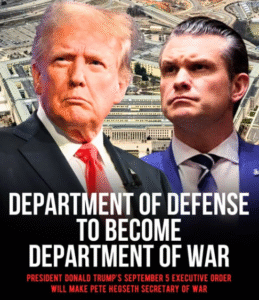From Defense to War: Trump’s Warrior Ethos and the Rebranding of America’s Military Identity
In a move that has stirred both admiration and controversy, President Donald Trump signed an executive order on September 5, 2025, authorizing the Department of Defense to adopt the secondary title “Department of War.” The decision, part of a broader campaign to instill a “warrior ethos” across the U.S. military, marks a symbolic shift in how the administration views America’s role on the global stage—and how it wants the world to perceive it.
The announcement came during a Cabinet meeting at the White House, where Trump sat flanked by Secretary of State Marco Rubio and Secretary of Defense Pete Hegseth, the latter already referred to by Trump as “Secretary of War.” The executive order allows Hegseth and other officials to use the titles “Secretary of War,” “Deputy Secretary of War,” and “Department of War” in official correspondence, public communications, and ceremonial contexts.
“This isn’t just about a name,” Trump told reporters. “It’s about reclaiming our legacy. We won World War I and World War II with the Department of War. We were victorious, strong, respected. Then we changed it to the Department of Defense, and we started playing defense. That’s not who we are anymore”.
The rebranding effort is part of a larger cultural shift within the Pentagon, spearheaded by Hegseth, who has long advocated for a return to what he calls “warrior culture.” In recent interviews, he emphasized the importance of cultivating a mindset focused on readiness, lethality, and offensive capability. “We want warriors,” Hegseth said. “Folks who understand how to exact lethality on the enemy. We don’t want endless contingencies and just playing defense. Words and names matter. This is about ethos”.
The term “warrior ethos” itself is drawn from military doctrine and philosophy, often associated with elite combat units like the Navy SEALs and Army Rangers. It emphasizes discipline, courage, sacrifice, and the willingness to fight and win. By elevating this ethos to a departmental identity, the Trump administration is signaling a more aggressive posture—both in rhetoric and potentially in policy.
Historically, the Department of War was the original name of the U.S. military’s executive branch, established in 1789. It oversaw the Army and coordinated military operations until 1947, when the National Security Act reorganized the armed forces into the National Military Establishment, later renamed the Department of Defense in 1949. The change was meant to reflect a post-World War II vision of deterrence and diplomacy in the nuclear age.
Trump’s decision to revive the old name is not without precedent globally. Many countries, including Russia, China, and North Korea, maintain ministries of defense despite their aggressive military postures. The U.S., by contrast, has long used language that emphasizes restraint and protection. Critics argue that renaming the department could send the wrong message to allies and adversaries alike—that America is shifting from a posture of deterrence to one of provocation.
Supporters, however, see the move as a long-overdue correction. Senator Rick Scott of Florida praised the rebranding, saying, “The U.S. military is the most lethal fighting force on the planet, and restoring the Department of War name reflects our true capabilities to win wars, not just respond to them”.
Still, the practical implications of the change are significant. While the executive order allows for the use of “Department of War” as a secondary title, a full legal renaming would require congressional approval. Trump has expressed confidence that lawmakers will support the move if necessary, though some members of Congress have voiced concern. Senator Mark Kelly, a former Navy pilot, criticized the decision, noting that Trump himself avoided military service during the Vietnam War. “Only someone who avoided the draft would want to rename the Department of Defense to the Department of War,” Kelly said.
Beyond politics, the rebranding could carry a hefty price tag. Analysts estimate that changing signage, stationery, websites, and emblems across hundreds of Pentagon agencies and military bases worldwide could cost billions of dollars. This raises questions about fiscal priorities, especially as the administration seeks to reduce waste and streamline defense spending.
Yet for Trump and Hegseth, the cost is justified by the cultural impact. “It’s not just about the words,” Hegseth said. “It’s about the warrior ethos. It’s about reminding our troops—and our enemies—that we fight to win”.
The announcement has sparked debate across military circles, think tanks, and media outlets. Some veterans have welcomed the change, seeing it as a return to clarity and purpose. Others worry it could glorify conflict and undermine diplomatic efforts. Military historian Andrew Bacevich noted that while the Department of War evokes a proud legacy, it also risks romanticizing violence. “War is not just a tool of policy—it’s a human tragedy,” he said.
For now, the Pentagon will begin implementing the executive order by updating public-facing materials and renaming the public affairs briefing room the “Pentagon War Annex”. Longer-term projects are in development, and Hegseth has been tasked with proposing legislative and executive actions to make the name permanent.
Whether the change endures or fades with the administration, it marks a pivotal moment in America’s military narrative. It’s a reassertion of identity, a reframing of purpose, and a reflection of the values the current leadership wants to champion.
In the end, the question may not be whether the name “Department of War” is more accurate—but whether it reflects the kind of nation America wants to be.


